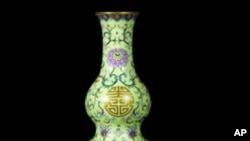A rare collection of Chinese art works and ceramics fetched record prices in a Hong Kong auction, with wealthy mainland Chinese buyers eagerly raising their paddles to win sought after treasures.
A Qing dynasty yellow-ground vase, decorated with flowers and edged in gilt, broke the world record for the most expensive single piece of Chinese art sold, at $32.5 million. It was just part of what the auction house Sotheby's called the largest sale of Chinese ceramics and works of art in the world.
In one day, 35 rare pieces sold for $148 million. Nicolas Chow, deputy chairman of Sotheby's Asia, says this week's series of auctions in Hong Kong breaks previous Chinese art auction records.
"This was the most extraordinary sale that the market has ever witnessed," he said. "This is a real, very dramatic entrance of Chinese art among the main collecting categories. I think when a sale brings in excess of 150 million I think we have to table [it] with the great collecting categories in the art world."
The Qing dynasty vase was expected to fetch at least $3.8 million. A similar vase sold for $6.9 million in 2008.
The buyer, Alice Cheng, is a Hong Kong collector, whose family had ties with the vase's previous owner, the renowned Shanghai-born, New York antique collector J.T. Tai. Many of rare porcelains auctioned off this week came from Tai's vast collection.
A white jade Qing dynasty seal sold for $16 million, four times its expected price.
Chow says the week-long auctions have drawn hundreds of collectors, mostly wealthy mainland Chinese buyers. "It's very clear that the Chinese are buying back their culture, it's part of the process of rebuilding their identity. It's to some extent understandable given the very particular history of China in the second part of the 20th century," he said.
After China's Communist Party won the country's civil war in 1949, many wealthy families fled overseas, taking along thousands of works of art. And many works were lost, destroyed or hidden in the 1960s, as China went through the political upheaval of the Cultural Revolution.
Hong Kong is the third-largest art auction location in the world after New York and London. China's expanding ranks of millionaires has not only fueled demand for art, but also rare French wines and luxury properties. This week, Sotheby's opened a real estate office in Hong Kong for clients seeking the city's most sought-after addresses.
Wealthy Chinese Buyers Break Records in Chinese Art Auctions







